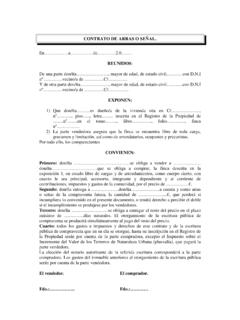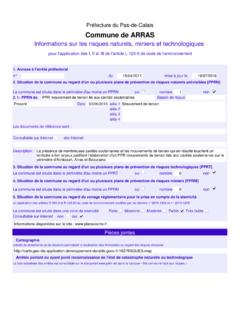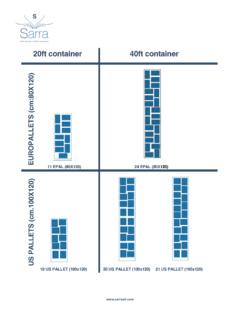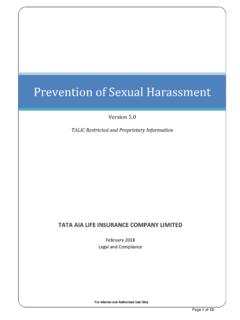Transcription of Selection of Fluorophore and Quencher Pairs for ...
1 31 _____Selection of Fluorophore and Quencher Pairsfor Fluorescent Nucleic Acid Hybridization ProbesSalvatore A. E. MarrasPublic Health Research Institute, 225 Warren Street, Newark,New Jersey 07103, USA. Email: the introduction of simple and relatively inexpensive methods for labelingnucleic acids with non-radioactive labels, doors have been opened that enable nucleicacid hybridization probes to be used for research and development, as well as forclinical diagnostic applications. The use of fluorescent hybridization probes thatgenerate a fluorescence signal only when they bind to their target enables real-timemonitoring of nucleic acid amplification assays. The use of hybridization probes thatbind to the amplification products in real-time, markedly improves the ability toobtain quantitative results.
2 Furthermore, real-time nucleic acid amplification assayscan be carried out in sealed tubes, eliminating carryover contamination. Sincefluorescent hybridization probes are available in a wide range of colors, multiplehybridization probes, each designed for the detection of a different nucleic acidsequence and each labeled with a differently colored Fluorophore , can be added to thesame nucleic acid amplification reaction, enabling the development of high-throughput multiplex assays. It is therefore important to carefully select the labels ofhybridization probes, based on the type of hybridization probe used in the assay, thenumber of targets to be detected, and the type of apparatus available to perform theassay. This chapter outlines different aspects of choosing appropriate labels for thedifferent types of fluorescent hybridization probes used with different types ofspectrofluorometric thermal Words: Fluorescent hybridization probes; Energy transfer; FRET; Contact quenching;Spectrofluorometric thermal : Methods in Molecular Biology: Fluorescent Energy Transfer Nucleic Acid Probes: Designs andProtocols.
3 Edited by: Didenko Humana Press Inc., Totowa, NJInteractive Fluorophore and Quencher PairsMarras41. Fluorescence Energy TransferDuring the last decade, many different types of fluorescent hybridization probes havebeen introduced. Although the mechanism of fluorescence generation is different amongthe different types of fluorescent hybridization probes, they all are labeled with at leastone molecule, a Fluorophore , that has the ability to absorb energy from light, transfer thisenergy internally, and emit this energy as light of a characteristic wavelength. In brief,following the absorption of energy (a photon) from light, a Fluorophore will be raisedfrom its ground state to a higher vibrational level of an excited singlet state. This processtakes about one femtosecond (10-15 seconds).
4 In the next phase, some energy is lost asheat, returning the Fluorophore to the lowest vibrational level of an excited singlet process takes about one picosecond (10-12 seconds). The lowest vibrational level ofan excited singlet state is relatively stable and has a longer lifetime of approximately oneto ten nanoseconds (1 to 10 x 10-9 seconds). From this excited singlet state, thefluorophore can return to its ground state, either by emission of light (a photon) or by anon-radiative energy transition. Light emitted from the excited singlet state is calledfluorescence. Since some energy is lost during this process, the energy of the emittedfluorescence light is lower than the energy of the absorbed light, and therefore emissionoccurs at a longer wavelength than processes can decrease the intensity of fluorescence.
5 Such decreases influorescence intensity are called quenching . Nowadays, most fluorescence detectiontechniques are based on quenching of fluorescence by energy transfer from onefluorophore to another Fluorophore or to a non-fluorescent molecule. The next sectiondescribes two mechanisms of fluorescence quenching utilized by fluorescenthybridization Fluorescent Resonance Energy TransferOne mechanism of energy transfer between two molecules is fluorescence resonanceenergy transfer (FRET) or F rster type energy transfer (1). In this non-radiative process,a photon from an energetically excited Fluorophore , the donor , raises the energy state ofan electron in another molecule, the acceptor , to higher vibrational levels of the excitedsinglet state.
6 As a result, the energy level of the donor Fluorophore returns to the groundstate, without emitting fluorescence. This mechanism is dependent on the dipoleorientations of the molecules and is limited by the distance between the donor and theacceptor molecule. Typical effective distances between the donor and acceptor moleculesare in the 10 to 100 range (2). This is roughly the distance between three to thirtynucleotides located in the double helix of a DNA molecule. Another requirement is thatthe fluorescence emission spectrum of the donor must overlap the absorption spectrum ofthe acceptor. The acceptor can be another Fluorophore or a non-fluorescent molecule. Ifthe acceptor is a Fluorophore , the transferred energy can be emitted as fluorescence,Interactive Fluorophore and Quencher PairsMarras5characteristic for that Fluorophore .
7 If the acceptor is not fluorescent, the absorbed energyis lost as heat. Examples of hybridization probes utilizing FRET for energy transferbetween two molecules are adjacent probes and 5'-nuclease probes, which are describedin the Subheading Contact quenchingQuenching of a Fluorophore can also occur as a result of the formation of a non-fluorescent complex between the Fluorophore and another Fluorophore or non-fluorescentmolecule. This mechanism is known as ground-state complex formation, staticquenching, or contact quenching. In contact quenching, the donor and acceptormolecules interact by proton-coupled electron transfer through the formation of hydrogenbonds. In aqueous solutions, electrostatic, steric and hydrophobic forces control theformation of hydrogen bonds.
8 When this complex absorbs energy from light, the excitedstate immediately returns to the ground state without emission of a photon and themolecules do not emit fluorescent light. A characteristic of contact quenching is a changein the absorption spectra of the two molecules when they form a complex. In contrast, inthe FRET mechanism, the absorption spectra of the molecules do not change. Among thehybridization probes that use this mechanism of energy transfer are molecular beaconprobes and strand-displacement probes, which are described in Subheading Fluorescence Nucleic Acid Hybridization ProbesSubheadings provide short descriptions of the four main types of fluorescenthybridization probes that use FRET or contact quenching to generate a fluorescencesignal to indicate the presence of a target nucleic acid: adjacent probes, 5'-nucleaseprobes, molecular beacon probes and strand-displacement probes.
9 Other fluorescenthybridization probes are similar, or are based on one of the four main types of 1 provides an overview of different types of fluorescent hybridization probes andtheir mechanism of energy transfer between Fluorophore and Quencher Adjacent Probes Adjacent probe (or LightCycler hybridization probe) assays utilize two single-stranded hybridization probes that bind to neighboring sites on a target nucleic acid (seeFig. 1A) (3). One probe is labeled with a donor Fluorophore at its 3' end, and the otherprobe is labeled with an acceptor Fluorophore at its 5' end. The distance between the twoprobes, once they are hybridized, is chosen such that efficient fluorescence resonanceenergy transfer (FRET) can take place from the donor to the acceptor Fluorophore .
10 Noenergy transfer should occur when the two probes are free-floating, separated from eachother in the solution. Hybridization of the probes to a target nucleic acid is measured bythe decrease in donor fluorescence signal or the increase in acceptor fluorescence Fluorophore and Quencher PairsMarras6 Table 1. Fluorescent nucleic acid hybridization probes and their mechanism ofenergy transferA) Quenching of the Fluorophore by FRET can occur if the Fluorophore and Quencher pair havespectral overlap and remain within sufficient distance of each other for efficient energy transfer tooccur; B) Quenching of the Fluorophore by contact quenching can occur if the Fluorophore comesin close proximity to the Quencher molecule or to a nucleotide, due to internal hybrid formationwithin the 5'-Nuclease Probes 5'-nuclease probe (or TaqMan probe) assays utilize the inherent endonucleolyticactivity of Taq DNA polymerase to generate a fluorescence signal (4).





